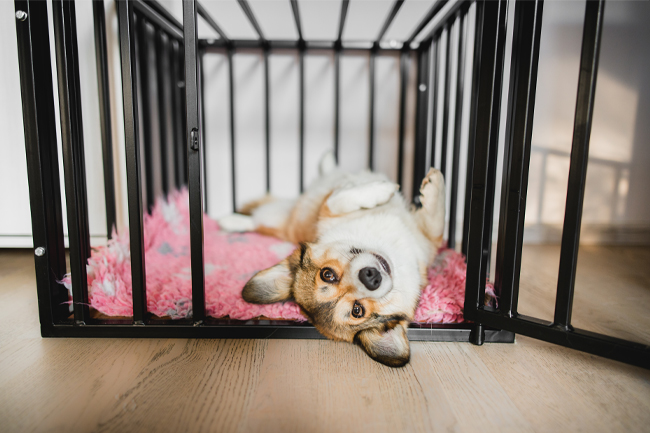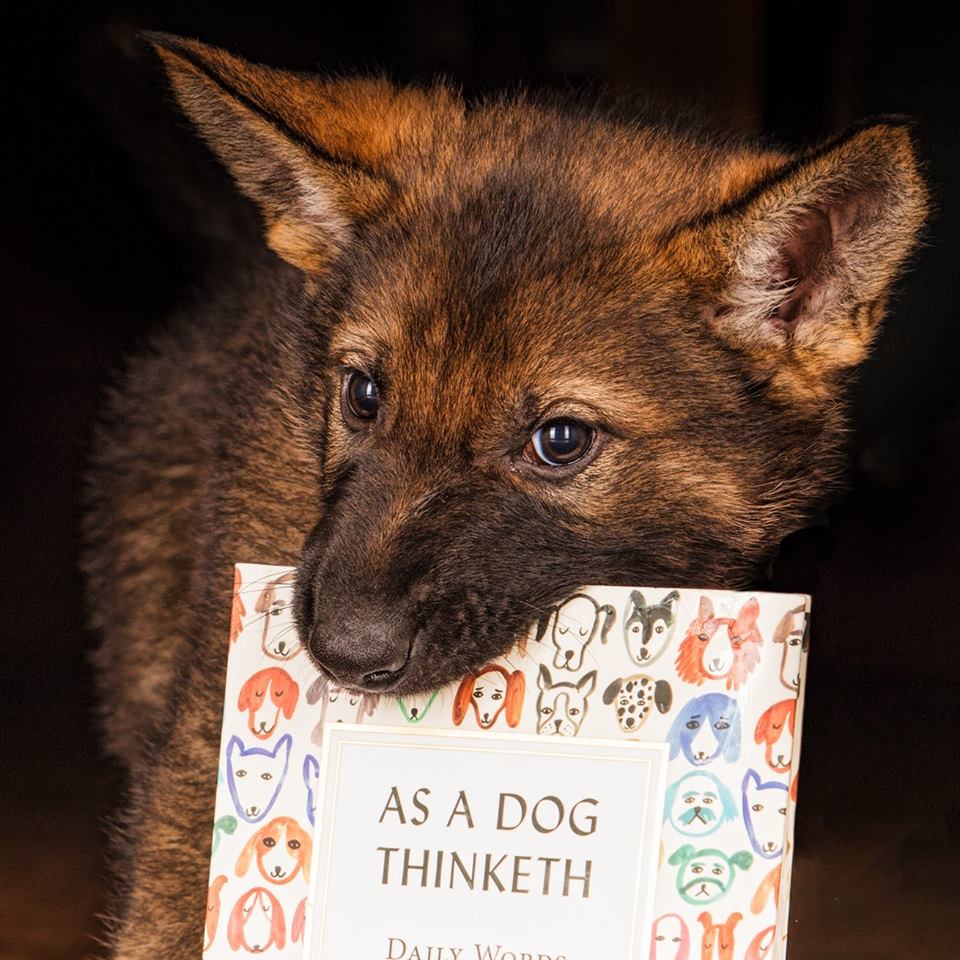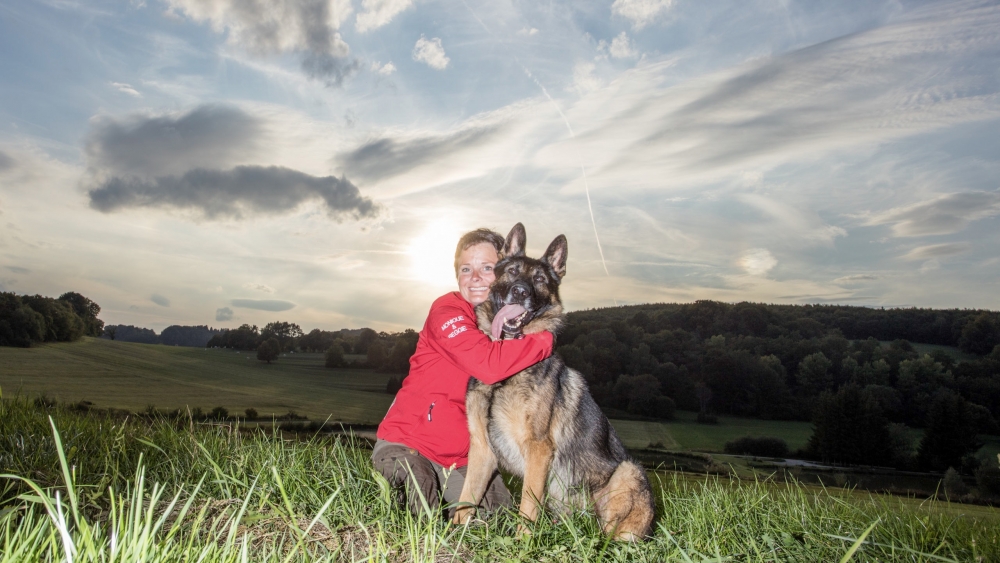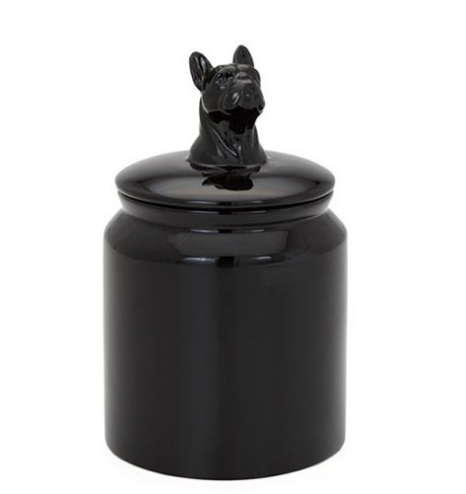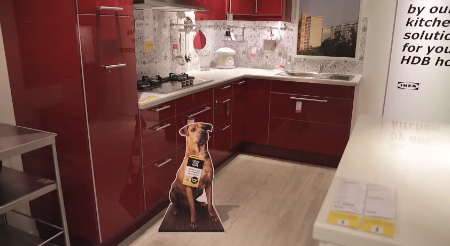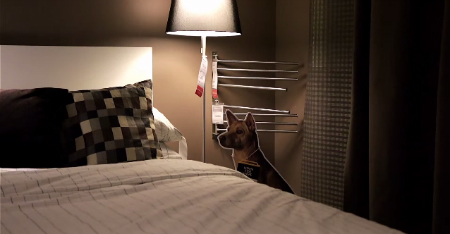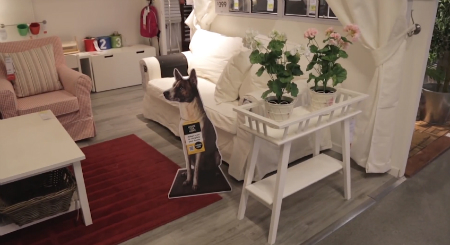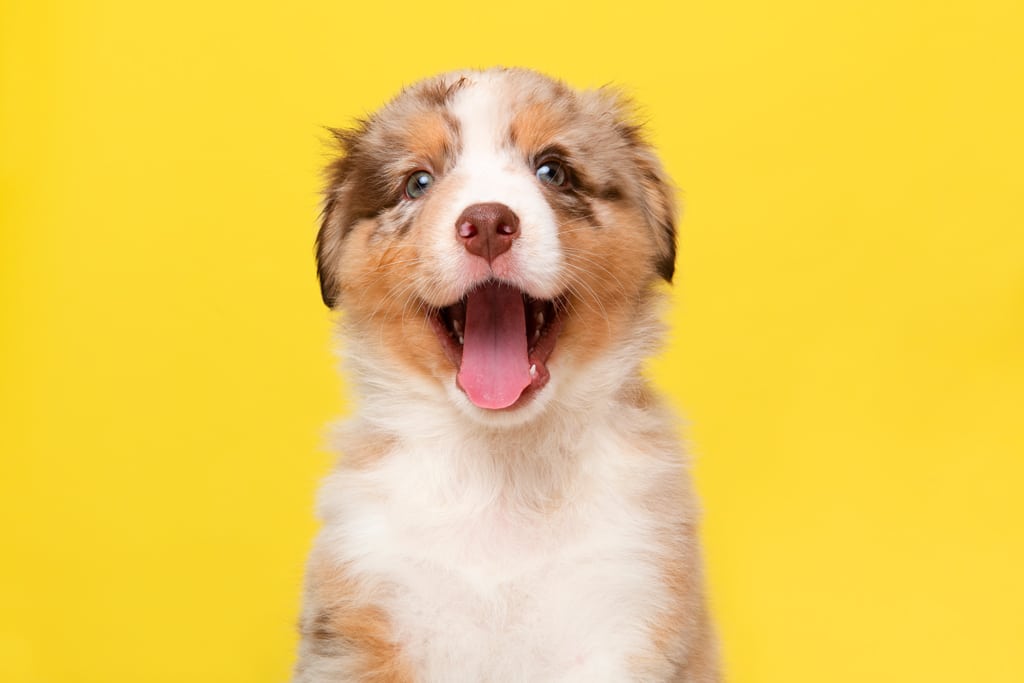- Dog CareDog LifeCommunity
- Photo Contest
Photo Contest- Giveaways
Crate Crying: What to do if Your Puppy Cries in Their Crate
Does your puppy cry in her crate? Here are 10 tips to help your puppy learn the crate is a safe and happy place.
- Feed all your puppy’s meals in the crate, with the door shut. Mealtime is typically happy time, so you’ll be associating meals with the crate.
- Give food-stuffed toys in the crate to occupy and delight your pup during confinement.
- Teach your puppy to go in and out of her crate on cue. Crate training games build positive associations.
- Don’t let your pup out of the crate if she is whining or crying, or you will reward this behaviour. Wait until she is quiet, even if just for a moment.
- Don’t only crate your pup when you leave the house, or you’ll associate the crate with your absence.
- If possible, put the crate in your bedroom.
- Always leave several safe toys in the crate to give your puppy something to do. Rotate them every day so she won’t get bored with them.
- Make sure the crate is the right size. Your pup should be able to easily stretch out, toe to toe.
- When your pup is alone in her crate, put on the TV or music.
- If your puppy still doesn’t love her crate, call a professional to help you.
How long can puppies stay in their crate? In general, young puppies 8-11 weeks will need an elimination break every two hours. From 12-14 weeks, they can “hold it” for 2.5 hours; 15-16 weeks, 3 hours.
Photo Jus_Ol/Shutterstock
5 REASONS TO USE A CRATE:
1. Helps with housetraining. Most puppies do not want to eliminate in confinement.
2. Keeps your household safe from chewing.
3. Keeps your puppy safe from chewing something dangerous.
4. Necessary if you ever have to board your puppy or your pup has to stay at the vet’s.
5. Keeps your puppy safe when you travel and stay in a hotel or another house.
This article originally appeared in the award-winning Modern Dog magazine. Subscribe today!
Socialize Your Puppy With This Bucket List From A Top Trainer
Monique Anstee is a nationally ranked obedience competitor and the founder and head trainer at the Naughty Dogge on Vancouver Island. She has distilled over 25 years of dog training experience into her first book, As A Dog Thinketh, in which she shares daily wisdom for all of your dog-related conundrums, including her hard-learned tips on
how best to socialize a puppy. Read on for some great advice from a top Canadian trainer.
Dogs need to be socialized. That means that dogs need to see the world and handle it with social grace. We need to teach them the skills and habits necessary for participating within our society.
Unfortunately, socialization is now commonly misunderstood and misinterpreted to mean just interacting and playing with other dogs. While puppies do need to play with other puppies, this is a teeny-tiny piece of their education, but somehow it’s become the only piece that many people focus on.
Here is a list of excellent activities you can do with your puppy to properly socialize him or her. I call it my puppy socialization bucket list, and it’s one of my most sought-after pieces of writing:
- Give your puppy a ride in a wheelbarrow, but keep a hand on his collar so he doesn’t leap out.
- Walk over many, many bridges of different surfaces, widths, and heights, with variations in the gaps in between planks.
- Climb driftwood at the beach for footing, balance, and learning how to use her body
- Climb rocks at the beach.
- Take your puppy to dog-friendly stores.
- Take your puppy to the pet store, but be careful of overly friendly strangers who may not leave your dog alone.
- Take your puppy on a busy path alongside a road where you’ll encounter heavy traffic, the odd pedestrian bridge, people, bikes, dogs, joggers, etc.
- Expose your puppy to many types of floor surfaces.
- You may want to bring your puppy to the dog park, but make sure to hold her in your arms as you pass by other dogs, and if there are dogs that you know to be very safe and kind, you can allow them to meet on the ground.
- Take a walk with a trusted friend and his or her dog, if you know the dog to be kind and calm.
- Expose your dog to children by sitting outside playgrounds.
- Hang out with chickens, ducks, and goats. When my puppy thought the goats were really scary, I protected her on my lap.
- Toss your dog into a giant box stuffed full of teddy bears. When she’s covered, have her crawl her way out.
- Throw towels over top of your puppy’s head, and graduate to entire sheets; she has to find her way out.
- Hold your puppy for cuddling and kisses every night.
- Handle and or trim your puppy’s toenails weekly.
- Cuddle and kiss your puppy as she chews on her bones, sometimes. Certainly not always.
- Walk to a new place every single day. Try not to repeat your walks.
- Crate your puppy every single day for varying lengths of times.
- Make sure your puppy has travelled in different vehicles, in different types of crates or seating arrangements.
- Take your puppy to a greenhouse or nursery, and make friends with all the staff inside.
- If your puppy is really friendly, teach her the art of walking past people without always saying hello. Walk past at least four out of five people without greeting, otherwise her friendliness will be annoying when she is big and strong.
- Maybe one of the most important things: she can pee and poop on grass, gravel, asphalt, or cement, on a leash or free. This makes travelling very simple.
- Every day she is presented with small problems that she must solve: how to get the ball that rolled under the couch, how to get the marrow out of her bone, how to stay on a bridge without falling off, how to climb over a downed tree that is higher than she thinks she can climb. I help her but never do I do it for her. And I only help enough so that she has the confidence to do the rest. If she puts in no effort, I will not help her.
- Teach your puppy to come running back fast at the sound of her name, no matter the distraction. Make sure “come” means that she chases you.
- Have play dates with trusted dog friends.
- Walk on all types of stairs.
- Take your puppy in a boat or a kayak; let her jump in and out.
- Go swimming with a slow steady introduction to water.
- Take your puppy to the petting zoo to meet all the animals, and more importantly, all the children.
- Watch an adult herding sheep. My puppy’s eyes almost popped out of her head.
- Swing with your puppy in a hammock.
- Take your puppy to a playground. Sit on a swing with your puppy, and go down the slide with your puppy in your lap.
- Play soccer with your puppy, and tackle the ball from her when she has a hold of it in her paws.
- Take your puppy on vacation with you and stay in hotels and other people’s houses.
- Take your puppy in an elevator and go through automatic doors.
- Expose your puppy to someone who smells of cigarette smoke. Many dogs are sensitive to different odours on people.
- Walk past a person in a wheelchair.
- Hang out at the vet’s and get cookies!
Socialization is about teaching life skills to your puppy. I exposed my puppy to every possible skill that she might need to be a functional adult. With all of the exposure and success comes a level of confidence and bravery; they will get to the point where they believe they are invincible. Even when she gets into trouble, she knows I am right there behind her to help her with her difficulties.
When puppies feel overwhelmed or scared, hold them in your arms, rather than leaving them on the floor. They can watch from up high, and then they’ll start wriggling like a mad thing wanting to get down and do it themselves. Rather than asking them to try it, by taking that option away and making them feel safe they have to then demand they be allowed to try it. This is a difference between feeling forced into an experience and choosing an experience. And when they choose the experience, they will be braver.
My last puppy never did have one “bad” experience. Unfortunately, it will happen, and when it does, they know that I am there to protect and help them. As they go on their adventures in the world, both good and bad, we are a team, and I have their back.
French Bulldog Treat Jar
I love this adorable French Bulldog treat jar from Torre & Tagus. It's a great and fashionable way of keeping all of my pups treats in one place. My favourite is the black jar, but it also comes in white as well. – CB
How IKEA is Helping Shelter Animals Find Their New Home
Do-it-yourself furniture retailer IKEA have found an innovative method of helping shelter animals find new homes and it’s gotten us excited.
How many Sunday afternoons have been spent strolling through sprawling IKEA warehouses using the mock living areas to visualize how that rug or that sofa would look in our homes? Well, if you find yourself at the Tempe, Arizona IKEA you might even discover a new best friend among the jungle of flat-pack shelving units.
It all started in Singapore with a partnership between IKEA and Homes for Hope. Cardboard cutouts of adoptable dogs were placed around participating stores, with barcodes that can be scanned to provide more information about the featured pooch.
IKEA Tempe has now partnered with Arizona Humane Society to help more animals find homes. An initial run saw six cutouts featured around the store, with all pets quickly adopted. Following the success, more cutouts will be making their way to the store beginning July 29th.
"We thought it was a perfect way to show people what their home would look like with a pet in it," IKEA Tempe's marketing director Becky Blaine told Business Insider.
Watch the program in action.
via Business Insider
Dogify Your Inbox
Sign up for the FREE Modern Dog Magazine newsletter & get the best of Modern Dog delivered to your inbox.
"*" indicates required fields
By clicking the arrow, you agree to our web Terms of Use and Privacy & Cookie Policy. Easy unsubscribe links are provided in every email.
